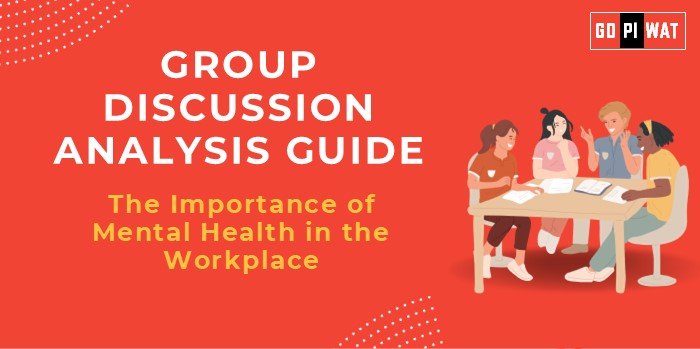📋 Group Discussion (GD) and WAT/Essay Analysis Guide: The Importance of Mental Health in the Workplace
🌐 Group Discussion Analysis Guide
Introduction to Mental Health in the Workplace
- Opening Context: “With 15% of the global working population experiencing mental health conditions (WHO, 2023), mental health has become a crucial concern for workplaces worldwide.”
- Topic Background: Workplace mental health involves promoting psychological well-being, reducing stigma, and creating supportive environments. Recent developments, like remote work and increasing burnout, have accelerated its significance.
📊 Quick Facts and Key Statistics
- 💰 Workplace Mental Health Impact: $1 trillion annual productivity loss globally (WHO, 2023).
- 🔥 Burnout Prevalence: 77% of employees report experiencing burnout at work (Gallup, 2023).
- 📉 Absenteeism Costs: Mental health issues cost employers $51 billion annually in lost productivity (APA).
- 📈 Awareness: 60% of organizations have started mental health programs but only 40% see tangible results.
🌟 Stakeholders and Their Roles
- 🏢 Employers: Implement mental health policies and foster a culture of openness.
- 👩💼 Employees: Advocate for their needs and utilize available resources.
- 🏛️ Government Bodies: Introduce laws, incentives, and awareness campaigns (e.g., Occupational Safety and Health Act).
- 🌐 NGOs/Health Experts: Provide research, counseling, and employee support.
🏆 Achievements and Challenges
Achievements
- ✔️ Policy Implementation: Companies like Unilever and Accenture have introduced mental health leaves and flexible work options.
- 📱 Digital Platforms: Mental wellness apps (e.g., Calm, BetterHelp) are widely adopted.
- 📅 Improved Awareness: Global events like World Mental Health Day (Oct 10) have elevated discussions.
Challenges
- ⚠️ Stigma: 70% of employees hide mental health struggles due to fear of judgment (Harvard Business Review).
- 💸 Resource Gaps: SMEs lack financial capacity for structured programs.
- 🌍 Global Comparison: Countries like Sweden provide robust mental health insurance, whereas developing nations lag.
Case Studies
- 🇮🇳 India: Tata Steel introduced 24×7 counseling for employees, reducing stress-related absenteeism by 20%.
- 🌐 Global: Microsoft’s mental health programs improved employee satisfaction by 15%.
📚 Structured Arguments for Discussion
- 🟢 Supporting Stance: “Mental health initiatives increase employee retention and performance, aligning with the organization’s financial goals.”
- 🔴 Opposing Stance: “Resource allocation to mental health can burden small organizations with limited budgets.”
- ⚖️ Balanced Perspective: “Mental health programs must scale across organizations with affordable, culturally appropriate solutions to ensure sustainable benefits.”
💡 Effective Discussion Approaches
- Opening Approaches:
- 📊 “Studies reveal that mental health issues cause $1 trillion in productivity loss annually. Isn’t it time organizations act?”
- 🔥 “Workplace burnout is a silent epidemic—77% employees report experiencing it globally.”
- Counter-Argument Handling:
- ✔️ Counter: “Small companies can’t afford mental health programs.”
- 💡 Rebuttal: “Affordable solutions like mental health webinars and employee assistance programs are scalable even for SMEs.”
- ✔️ Counter: “Small companies can’t afford mental health programs.”
📊 Strategic Analysis of Strengths and Weaknesses
- 🌟 Strengths: Increased productivity, reduced absenteeism, enhanced employee morale and loyalty.
- ⚠️ Weaknesses: Financial burden for SMEs, persistent stigma in traditional workplaces.
- 📈 Opportunities: Technology-enabled mental wellness programs, integration into corporate sustainability goals (ESG).
- ⚡ Threats: Lack of expertise in implementing mental health policies, growing stress due to hybrid work culture.
🎓 Connecting with B-School Applications
- 📈 Real-World Applications: Integration of mental health into HR case studies, CSR programs, and employee retention strategies.
- 📋 Sample Interview Questions:
- “How can companies strike a balance between mental health initiatives and profitability?”
- “Discuss the role of technology in workplace mental wellness.”
- 💡 Insights for B-School Students: Focus on HR innovations, change management, and corporate social responsibility (CSR) opportunities.


